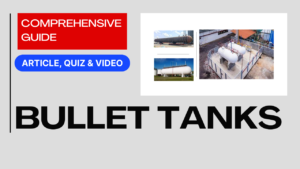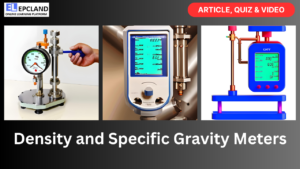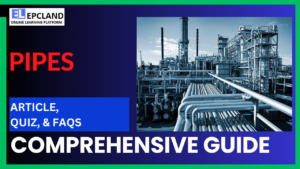1. What is the primary purpose of Supports Selection in piping systems?
Choose the correct statement.
Explanation: Supports in piping systems primarily serve to carry the weight of the piping system and prevent sagging and excessive stress.
2. What is the main function of restraints in Supports Selection in piping systems?
Choose the correct statement.
Explanation: Restraints in piping systems are designed to control or restrict the movement of the piping system, primarily due to thermal expansion and contraction.
3. How do supports help in reducing stress on a piping system?
Choose the correct statement.
Explanation: Supports help in reducing stress on a piping system by carrying the weight of the system and distributing loads, preventing sagging and excessive stress.
4. What is the primary reason for employing restraints in a piping system?
Choose the correct statement.
Explanation: Restraints are employed in a piping system to control or restrict movement, primarily due to thermal expansion and contraction.
5. What factors influence the selection of supports and restraints in a piping system?
Choose the correct statement.
Explanation: The selection of supports and restraints in a piping system depends on various factors, including the anticipated weight or force, size, and configuration, and the availability of nearby structural steel.
6. What does thermal expansion in a piping system lead to?
Choose the correct statement.
Explanation: Thermal expansion in a piping system leads to increased stress, which can be detrimental if not controlled.
7. Why is it essential to permit vertical thermal movement at a support in some cases?
Choose the correct statement.
Explanation: In some cases, it is necessary to permit vertical thermal movement at a support while restricting lateral movement to accommodate the thermal expansion of the piping system.
Short Article on Factors for Support Selection
Purpose of Supports and Restraints in Piping Systems
Piping systems are subjected to various loads and forces during operation, including the weight of the pipe and its contents, thermal expansion and contraction, fluid flow forces, and external loads such as wind and earthquakes. To ensure the stability, safety, and integrity of the piping system, supports and restraints are employed to manage these loads and prevent excessive movement.
Supports
Supports primarily serve to carry the weight of the piping system and its contents, preventing sagging and excessive stress. They also help to distribute loads and reduce the overall stress on the piping system. Supports are typically attached directly to the pipe and can be of various types, such as pipe shoes, saddles, and hangers.
Restraints
Restraints, on the other hand, are designed to control or restrict the movement of the piping system, primarily due to thermal expansion and contraction. Thermal expansion occurs when the piping system is subjected to heat, causing it to expand, while thermal contraction occurs when the temperature drops, causing the pipe to contract. Uncontrolled thermal movement can lead to excessive stress, damage to connected equipment, and potential leaks. Restraints are typically attached to the pipe and connected to structural elements or other fixed points to limit or guide the movement.
Factors Influencing Support and Restraint Selection
The selection of specific supports and restraints for a piping system depends on various factors, including:
- Load to be supported or absorbed: The load-bearing capacity of the support or restraint must be sufficient to handle the anticipated weight or force.
- Clearance available for attachment to pipe: The size and configuration of the support or restraint must fit within the available space around the pipe.
- Availability of nearby structural steel: Supports and restraints can often utilize existing structural supports, reducing installation costs and complexity.
- Direction of loads to be absorbed or movement to be restrained: The orientation and design of the support or restraint must align with the direction of the load or movement to be controlled.
- Design temperature: The material and design of the support or restraint must withstand the expected operating temperature range.
- Need to permit vertical thermal movement at a support: In some cases, it may be necessary to allow for vertical thermal movement while restricting lateral movement. Specialized supports can accommodate this requirement.
By carefully considering these factors, engineers can select the appropriate supports and restraints for each piping system, ensuring its stability, safety, and long-term integrity.
Table of Contents
Don’t miss the Course on Effective Isometrics Management: Check Now
Enrollment Link
Recommended courses (Published on EPCLand)
- Complete Course on Piping Engineering
- Basics of Piping Engineering
- Piping Layout Engineering
- Piping Material Engineering
- Piping Stress Analysis
- Material Requisitions
- Piping Material Specifications
- Valve Material Specifications
- Plant Design & Layouts-OISD 118
- Isometric Management
Library of Technical Articles
Don’t miss out the collection of 15+ articles on following topics:
- Basics of Oil and Gas Industry
- Valves
- Testing
- Tank
- Piping Bulk Items
- Pipe
- Metallurgy
- Piping Materials
- Layout
- Instrumentation
- Heat Exchanger
- Type of Contracts
- Codes and Standards
- ASTM Standards
- Articles on Piping Specialty Items
Video details of Complete Course on Piping Engineering
Why Enroll in the EPCLand
Proven Track Record– PTR
Activities & Achievements before launching EPCLand
- Published more than 50+ short courses
- 3000+ Enrolments
- More than 3,500,00 Minutes of watch hours in the last 2 years
- 4000+ Students in 100+ Countries
- Rating of 4+ out of 5
- 1000+ YouTube Videos
- 8K+ Subscribers
What Students will Learn
- Codes & Standards of the Energy Sector
- Piping Material Engineering
- Piping Layout Engineering
- Stress Analysis
Interesting facts
- All the published courses have been developed by Industry Experts with more than 2 decades of experience
- Content is based on Practical experience and real-time problems.
- Content is designed and organized in such a manner that it can be easily grabbed.
- Complete website, Blogs and Quiz sections are Planned, Designed and published by myself (About me: Atul Singla)
- Complete flexibility of Time & Location, Students can access the content from anywhere & anytime
- Moreover, once enrolled, the content can be access as many times as you want, which helps in understand the fundamentals in a better way.
Conclusion
In conclusion, our courses are meticulously crafted by industry experts with over two decades of hands-on experience. The content is rooted in practical knowledge, addressing real-time problems. The material is thoughtfully designed and organized for easy comprehension. Every aspect, from the website to blogs and quizzes, has been planned, designed, and executed by Atul Singla, ensuring a comprehensive and seamless learning experience. With the flexibility of accessing the content at any time and from any location, students have the freedom to learn on their terms. Furthermore, enrollment grants unlimited access, allowing learners to revisit the material as often as needed, fostering a deep understanding of the fundamentals.



